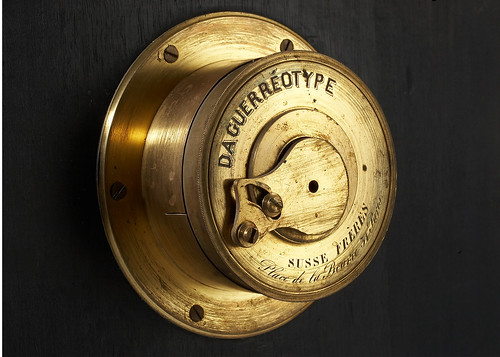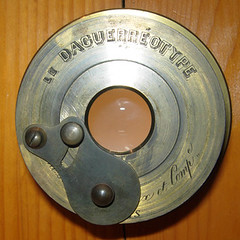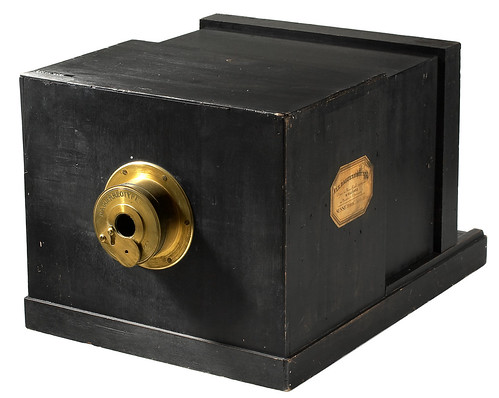Difference between revisions of "Le Daguerreotype"
m (photo link correction) |
(Added missing attributions & rights; re-arranged images & added Notes subhead) |
||
| Line 1: | Line 1: | ||
| − | + | {|class=floatright | |
| − | { | + | | |
| − | | | ||
| − | | | ||
| − | |||
| − | |||
| − | |||
| − | |||
| − | |||
| − | |||
{{Flickr_image | {{Flickr_image | ||
|image_source= http://www.flickr.com/photos/awcam/2749758101/in/pool-camerawiki/ | |image_source= http://www.flickr.com/photos/awcam/2749758101/in/pool-camerawiki/ | ||
|image= http://farm4.static.flickr.com/3225/2749758101_973c43b834.jpg | |image= http://farm4.static.flickr.com/3225/2749758101_973c43b834.jpg | ||
|image_align= right | |image_align= right | ||
| − | |image_text= Replica of an 1839 [[Alphonse Giroux|Giroux]]-built Daguerre camera<br />at the [http://www.dtmb.de/index_en.html Deutsches Technikmuseum, Berlin] | + | |image_text= Replica of an 1839 [[Alphonse Giroux|Giroux]]-built Daguerre camera<br />at the [http://www.dtmb.de/index_en.html Deutsches Technikmuseum, Berlin]. |
| + | |image_by=AWCam | ||
| + | |image_rights=wp | ||
}} | }} | ||
| + | |- | ||
| + | | | ||
{{Flickr_image | {{Flickr_image | ||
| − | |image_source= http://www.flickr.com/photos/ | + | |image_source= http://www.flickr.com/photos/37846760@N03/4871686747/ |
| − | |image= http:// | + | |image= http://farm5.static.flickr.com/4100/4871686747_bddbde1563.jpg |
| − | |image_align= | + | |image_align= right |
| − | |image_text= | + | |image_text= Original daguerreotype camera from 1839 built by [[Susse Frères]],<br/>Place de la Bourse 31, Paris. Camera at the [http://www.westlicht.at Westlicht Museum], Vienna, Austria. |
| − | + | |image_by= liudmilanelson1x1 | |
| − | + | |image_rights=cc | |
| − | |||
| − | |||
| − | | | ||
| − | | | ||
}} | }} | ||
| + | |} | ||
| + | '''Le Daguerreotype''' was [[Louis Jacques Mandé Daguerre]]'s main contribution to camera history: The sliding box camera was designed by him for his [[Daguerreotype Process|Daguerreotype process]]. Two variants were made since he gave production licences to two Parisian camera makers, [[Alphonse Giroux]] and the brethren Susse. Probably Giroux worked together with the optician Bianchi who had his shop in the same street. Thus the original "Le Daguerreotype" of Giroux with Daguerre's quality seal was basically the same as the sliding box camera offered by Bianchi, unsealed. One surviving camera of the Susse brothers' production was sold in a 2007 auction for a record price of 580,000€, and another in May 2010 for a record 732,000€ ($898,000 US)<ref>[http://britishphotohistory.ning.com/profiles/blogs/vintage-camera-auctioned-for British photographic history site]</ref>. | ||
| + | This was a sliding box camera - made of two boxes lined with black velvet, one slightly smaller, a close fit into the larger. The inner box with open front and screen in the back had to be shifted carefully into or out of the outer box for focusing. After focusing the screen had to be replaced with the holder for the light-sensitized plate. The front of the outer box held a [[meniscus lens]] in a brass barrel, named like the camera ''Le Daguerreotype'' and made by [[Charles Louis Chevalier|Charles Chevalier]] or by N. P. Lerebours. The lenses differed slightly in max. aperture (f14 to f17) and in [[Lens#Focal_Length|focal length]]. The camera was sold together with a plate holder with "barn doors", a plate sensitizing box, and a developing box. | ||
| − | + | ==Notes== | |
| − | |||
| − | |||
| − | |||
| − | |||
| − | |||
| − | |||
| − | |||
| − | |||
| − | |||
| − | |||
| − | |||
| − | |||
| − | |||
| − | |||
| − | |||
| − | |||
| − | |||
| − | |||
| − | |||
| − | |||
| − | |||
| − | |||
| − | |||
| − | |||
| − | |||
| − | |||
| − | |||
| − | |||
| − | |||
| − | |||
| − | |||
| − | |||
| − | |||
| − | |||
| − | |||
| − | |||
| − | |||
| − | |||
| − | |||
| − | |||
| − | |||
| − | |||
| − | |||
| − | |||
| − | |||
| − | |||
| − | |||
| − | |||
| − | |||
| − | |||
| − | |||
| − | |||
| − | |||
| − | |||
| − | |||
| − | |||
| − | |||
| − | |||
| − | |||
| − | |||
| − | |||
| − | |||
| − | |||
| − | |||
| − | |||
| − | |||
| − | |||
| − | |||
| − | |||
<references /> | <references /> | ||
| Line 109: | Line 35: | ||
*[http://www.deutsches-museum.de/sammlungen/ausgewaehlte-objekte/meisterwerke-iv/kamera/ Le Daguerreotype] at Deutsches Museum Munich | *[http://www.deutsches-museum.de/sammlungen/ausgewaehlte-objekte/meisterwerke-iv/kamera/ Le Daguerreotype] at Deutsches Museum Munich | ||
*[http://www.vieilalbum.com/DaguerreotypesUS.htm Collection of Daguerreotypes] at [http://www.vieilalbum.com www.vieilalbum.com] | *[http://www.vieilalbum.com/DaguerreotypesUS.htm Collection of Daguerreotypes] at [http://www.vieilalbum.com www.vieilalbum.com] | ||
| + | |||
| + | |||
| + | |||
| + | {{Flickr_image | ||
| + | |image_source= http://www.flickr.com/photos/37846760@N03/4872367744/ | ||
| + | |image= http://farm5.static.flickr.com/4081/4872367744_5986b95b56.jpg | ||
| + | |image_align= left | ||
| + | |image_text= Lens built by [[Charles Chevalier]] for the [[Susse Frères]] Daguerreotype camera. | ||
| + | |image_by= liudmilanelson1x1 | ||
| + | |image_rights=cc | ||
| + | }} | ||
| + | {{Flickr_image | ||
| + | |image_source= http://www.flickr.com/photos/awcam/2749758591/in/pool-camerawiki/ | ||
| + | |image= http://farm4.static.flickr.com/3230/2749758591_56f3749da0_m.jpg | ||
| + | |image_align= left | ||
| + | |image_text= Replica lens, with pivoting cap. | ||
| + | |image_by=AWCam | ||
| + | |image_rights=wp | ||
| + | }} | ||
| + | |||
[[Category:Daguerreotype camera]] | [[Category:Daguerreotype camera]] | ||
Revision as of 18:11, 31 October 2011
| ||
|
Le Daguerreotype was Louis Jacques Mandé Daguerre's main contribution to camera history: The sliding box camera was designed by him for his Daguerreotype process. Two variants were made since he gave production licences to two Parisian camera makers, Alphonse Giroux and the brethren Susse. Probably Giroux worked together with the optician Bianchi who had his shop in the same street. Thus the original "Le Daguerreotype" of Giroux with Daguerre's quality seal was basically the same as the sliding box camera offered by Bianchi, unsealed. One surviving camera of the Susse brothers' production was sold in a 2007 auction for a record price of 580,000€, and another in May 2010 for a record 732,000€ ($898,000 US)[1].
This was a sliding box camera - made of two boxes lined with black velvet, one slightly smaller, a close fit into the larger. The inner box with open front and screen in the back had to be shifted carefully into or out of the outer box for focusing. After focusing the screen had to be replaced with the holder for the light-sensitized plate. The front of the outer box held a meniscus lens in a brass barrel, named like the camera Le Daguerreotype and made by Charles Chevalier or by N. P. Lerebours. The lenses differed slightly in max. aperture (f14 to f17) and in focal length. The camera was sold together with a plate holder with "barn doors", a plate sensitizing box, and a developing box.
Notes
Links
- Message about the Susse camera auction in photoscala [1]
- Susse's camera at news24
- auction catalogue page, here another
- Earliest Giroux camera at Åke Hultman's [2]
- Le Daguerreotype at Deutsches Museum Munich
- Collection of Daguerreotypes at www.vieilalbum.com

|
| Lens built by Charles Chevalier for the Susse Frères Daguerreotype camera. image by liudmilanelson1x1 (Image rights) |

|
| Replica lens, with pivoting cap. image by AWCam (Image rights) |

